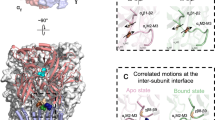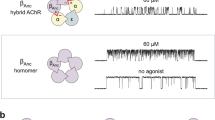Abstract
Synaptic receptors respond to neurotransmitters by opening an intrinsic ion channel in the final step in synaptic transmission. How binding of the neurotransmitter is conveyed over the long distance to the channel remains a central question in neurobiology. Here we delineate a principal pathway that links neurotransmitter binding to channel gating by using a structural model of the Torpedo acetylcholine receptor at 4-Å resolution1, recordings of currents through single receptor channels and determinations of energetic coupling between pairs of residues. We show that a pair of invariant arginine and glutamate residues in each receptor α-subunit electrostatically links peripheral and inner β-sheets from the binding domain and positions them to engage with the channel. The key glutamate and flanking valine residues energetically couple to conserved proline and serine residues emerging from the top of the channel-forming α-helix, suggesting that this is the point at which the binding domain triggers opening of the channel. The series of interresidue couplings identified here constitutes a primary allosteric pathway that links neurotransmitter binding to channel gating.
This is a preview of subscription content, access via your institution
Access options
Subscribe to this journal
Receive 51 print issues and online access
$199.00 per year
only $3.90 per issue
Buy this article
- Purchase on Springer Link
- Instant access to full article PDF
Prices may be subject to local taxes which are calculated during checkout



Similar content being viewed by others
References
Unwin, N. Refined structure of the nicotinic acetylcholine receptor at 4 Å resolution. J. Mol. Biol. 346, 967–989 (2005)
Kash, T., Jenkins, A., Kelly, J., Trudell, J. & Harrison, N. L. Coupling of agonist binding to channel gating in the GABAA receptor. Nature 421, 272–275 (2003)
Bouzat, C. et al. Coupling of agonist binding to channel gating in an ACh-binding protein linked to an ion channel. Nature 430, 896–900 (2004)
Gao, F. et al. Agonist-mediated conformational changes in acetylcholine-binding protein revealed by simulation and intrinsic tryptophan fluorescence. J. Biol. Chem. 280, 8443–8451 (2005)
Law, R., Henchman, R. & McCammon, J. A. A gating mechanism proposed from a simulation of a human α7 nicotinic acetylcholine receptor. Proc. Natl Acad. Sci. USA 102, 6813–6818 (2005)
Unwin, N., Miyazawa, A., Li, J. & Fujiyoshi, Y. Activation of nicotinic acetylcholine receptor involves a switch in conformation of the α subunits. J. Mol. Biol. 319, 1165–1176 (2002)
Celie, P. H. N. et al. Nicotine and carbamylcholine binding to nicotinic acetylcholine receptors as studied in AChBP crystal structures. Neuron 41, 907–914 (2004)
Colquhoun, D. & Sakmann, B. Fluctuations in the microsecond time range of the current through single acetylcholine receptor ion channels. Nature 294, 464–466 (1981)
Sine, S. M., Claudio, T. & Sigworth, F. J. Activation of Torpedo acetylcholine receptors expressed in mouse fibroblasts. Single channel current kinetics reveal distinct agonist binding affinities. J. Gen. Physiol. 96, 395–437 (1990)
Grosman, C., Zhou, M. & Auerbach, A. Mapping the conformational wave of acetylcholine receptor channel gating. Nature 403, 773–776 (2000)
Lee, W. Y. & Sine, S. M. Invariant aspartic acid in muscle nicotinic receptor contributes selectively to the kinetics of agonist binding. J. Gen. Physiol. 124, 555–567 (2004)
Horovitz, A. & Fersht, A. Strategy for analyzing the co-operativity of intramolecular interactions in peptides and proteins. J. Mol. Biol. 214, 613–617 (1990)
Vaughan, C., Harryson, P., Buckle, A. & Fersht, A. A structural double-mutant cycle: estimating the strength of a buried salt bridge in barnase. Acta Crystallogr. D 58, 591–600 (2002)
Castaldo, P. et al. A novel hyperekplexia-causing mutation in the pre-transmembrane segment 1 of the human glycine receptor α1 subunit reduces membrane expression and impairs gating by agonists. J. Biol. Chem. 279, 25598–25604 (2004)
Vicente-Agullo, F. et al. Multiple roles of the conserved key residue arginine 209 in neuronal nicotinic receptors. Biochemistry 40, 8300–8306 (2001)
Kash, T. L., Dizon, M. J., Trudell, J. R. & Harrison, N. L. Charged residues in the β2 subunit involved in GABAA receptor activation. J. Biol. Chem. 279, 4887–4893 (2004)
Hu, X. Q., Zhang, L., Stewart, R. R. & Weight, F. F. Arginine 222 in the pre-transmembrane domain 1 of 5-HT3A receptors links agonist binding to channel gating. J. Biol. Chem. 278, 46583–46589 (2003)
Wilson, G. G. & Karlin, A. The location of the gate in the acetylcholine receptor channel. Neuron 20, 1269–12681 (1998)
Serrano, L., Horovitz, A., Avron, B., Bycroft, M. & Fersht, A. Estimating the contribution of engineered surface electrostatic interactions to protein stability by using double-mutant cycles. Biochemistry 29, 9343–9352 (1990)
Sine, S. M. The nicotinic receptor ligand binding domain. J. Neurobiol. 3, 431–446 (2002)
Lyford, L. K., Sproul, A. D., Eddins, D., McLaughlin, J. T. & Rosenberg, R. L. Agonist-induced conformational changes in the extracellular domain of α7 nicotinic acetylcholine receptors. Mol. Pharmacol. 64, 650–658 (2003)
Schofield, C. M., Jenkins, A. & Harrison, N. L. A highly conserved aspartic acid residue in the signature disulfide loop of the α1 subunit is a determinant of gating in the glycine receptor. J. Biol. Chem. 278, 34079–34083 (2003)
Absalom, N. L., Lewis, T. M., Kaplan, W., Pierce, K. D. & Schofield, P. R. Role of charged residues in coupling ligand binding and channel activation in the extracellular domain of the glycine receptor. J. Biol. Chem. 278, 50151–50157 (2003)
Chakrapani, S., Bailey, T. D. & Auerbach, A. Gating dynamics of the acetylcholine receptor extracellular domain. J. Gen. Physiol. 123, 341–356 (2004)
Sala, F., Mulet, J., Sala, S., Gerber, S. & Criado, M. Charged amino acids of the N-terminal domain are involved in coupling binding and gating in α7 nicotinic receptors. J. Biol. Chem. 280, 6642–6647 (2005)
Croxen, R. et al. Mutations in different functional domains of the human muscle acetylcholine receptor α subunit in patients with the slow-channel congenital myasthenic syndrome. Hum. Mol. Gen. 6, 767–774 (1997)
Shen, X. M. et al. Mutation causing severe myasthenia reveals functional asymmetry of AChR signature cystine loops in agonist binding and gating. J. Clin. Invest. 111, 497–505 (2003)
Sine, S. M. et al. Naturally-occurring mutations at the acetylcholine receptor binding site independently alter ACh binding and channel gating. J. Gen. Physiol. 120, 483–496 (2002)
Humphrey, W., Dalke, A. & Schulten, K. VMD—visual molecular dynamics. J. Mol. Graphics 14, 33–38 (1996)
Qin, F., Auerbach, A. & Sachs, F. Estimating single channel kinetic parameters from idealized patch clamp data containing missed events. Biophys. J. 70, 264–280 (1996)
Acknowledgements
We thank C. R. Free for contributions to the molecular biology and T. Therneau for help with statistical analysis. This work was supported by a grant from the NIH.
Author information
Authors and Affiliations
Corresponding author
Ethics declarations
Competing interests
Reprints and permissions information is available at npg.nature.com/reprintsandpermissions. The authors declare no competing financial interests.
Supplementary information
Supplementary Methods
This is an additional information regarding the experimental methods not included in the main text. (DOC 26 kb)
Supplementary Table 1
Kinetic analysis of AChRs with mutations in the α-subunit. (DOC 81 kb)
Supplementary Table S2
Kinetic analysis of AChRs with mutations in non-α-subunits. (DOC 61 kb)
Supplementary Table S3
Sequence alignments of receptors in the Cys-loop superfamily. (DOC 41 kb)
Rights and permissions
About this article
Cite this article
Lee, W., Sine, S. Principal pathway coupling agonist binding to channel gating in nicotinic receptors. Nature 438, 243–247 (2005). https://doi.org/10.1038/nature04156
Received:
Accepted:
Issue Date:
DOI: https://doi.org/10.1038/nature04156
This article is cited by
-
A release of local subunit conformational heterogeneity underlies gating in a muscle nicotinic acetylcholine receptor
Nature Communications (2024)
-
Mechanism of pore opening in the calcium-activated chloride channel TMEM16A
Nature Communications (2021)
-
An allosteric link connecting the lipid-protein interface to the gating of the nicotinic acetylcholine receptor
Scientific Reports (2018)
-
The neural γ2α1β2α1β2 gamma amino butyric acid ion channel receptor: structural analysis of the effects of the ivermectin molecule and disulfide bridges
Journal of Molecular Modeling (2018)
-
Pentameric ligand-gated ion channels exhibit distinct transmembrane domain archetypes for folding/expression and function
Scientific Reports (2017)
Comments
By submitting a comment you agree to abide by our Terms and Community Guidelines. If you find something abusive or that does not comply with our terms or guidelines please flag it as inappropriate.



